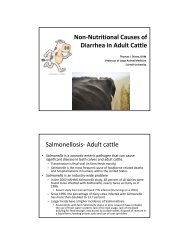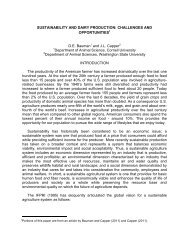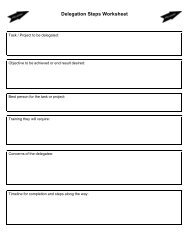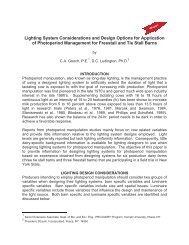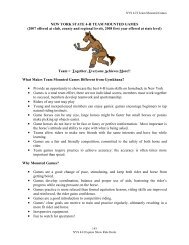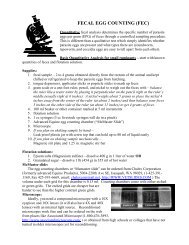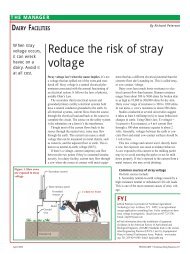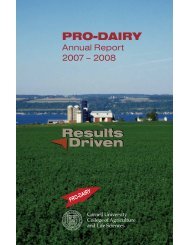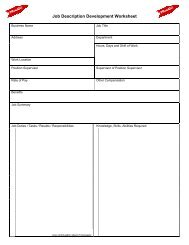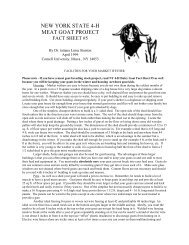Ventilation & lighting in goat barns - Cornell University
Ventilation & lighting in goat barns - Cornell University
Ventilation & lighting in goat barns - Cornell University
You also want an ePaper? Increase the reach of your titles
YUMPU automatically turns print PDFs into web optimized ePapers that Google loves.
<strong>Ventilation</strong> and Light<strong>in</strong>g for Goat Barns –by Carol Delaney (Univ. of Vermont Small Rum<strong>in</strong>ant Dairy Specialist)At this time of year <strong>in</strong> our climate, we need to be aware of the environment wesubject <strong>goat</strong>s to when they are kept <strong>in</strong> a barn. For those that conf<strong>in</strong>e their <strong>goat</strong>s year-round,this concern of adjustments for the w<strong>in</strong>ter months will match those that are br<strong>in</strong>g<strong>in</strong>g <strong>in</strong> their<strong>goat</strong>s from graz<strong>in</strong>g. In France, most <strong>goat</strong> dairies are conf<strong>in</strong>ement systems with the exceptionof farms <strong>in</strong> Southern and Eastern France where it is more mounta<strong>in</strong>ous and wheregraz<strong>in</strong>g/brows<strong>in</strong>g is preferred or required. (To make Crott<strong>in</strong> de Chavignol cheese, <strong>goat</strong>s mustbe outside graz<strong>in</strong>g.) So, French dairy <strong>goat</strong> farmers are keenly aware of what conditions <strong>in</strong>the barn are optimal for <strong>goat</strong> health. Here are some of their and US recommendations forventilation and <strong>light<strong>in</strong>g</strong>.In general, natural <strong>light<strong>in</strong>g</strong> should give light to 1/20 th of the floor area and come <strong>in</strong>laterally, i.e. from side w<strong>in</strong>dows. Artificial <strong>light<strong>in</strong>g</strong> with fluorescent lights is preferred andthose lights should be <strong>in</strong> a protective cas<strong>in</strong>g and placed about every 18-20 feet (6 meters)aga<strong>in</strong>st the wall at a height of about 6-8 feet (3-3.5 meters). For out of season breed<strong>in</strong>g,provide enough light to give the <strong>goat</strong>s 2,000 foot-candles (200 lux) down at their level.Make sure bucks get this treatment, too.Air <strong>in</strong> the barn, without any ventilation, will accumulate gases (ammonia, carbondioxide/monoxide, hydrogen sulfide and methane), moisture, heat and contam<strong>in</strong>ants like dustand airborne pathogens. If you can detect the smell of ammonia with your nose, the airquality is poor and ventilation is <strong>in</strong>sufficient. Gases come from the animals’ respiration andaerobic and anaerobic fermentation of ur<strong>in</strong>e and feces <strong>in</strong> the bedd<strong>in</strong>g. Moisture accumulatesbecause each <strong>goat</strong> secretes out up to 2-3 quarts (2-3 liters or ~7 lbs) of water each day <strong>in</strong> theform of breathe and body vapor along with ur<strong>in</strong>e and feces. Heat sources are the <strong>goat</strong>sthemselves, radiant head on roof and through open side walls, lights, fans and the manurepack ferment<strong>in</strong>g/compost<strong>in</strong>g at around 130 °F.A litter base of 8-24 <strong>in</strong>ches (20-60 cm) of straw, hay or sawdust provides goodthermal <strong>in</strong>sulation from the ground and acts as a sponge to soak up moisture. This isprovided the bedd<strong>in</strong>g is changed regularly and is not wet when you kneel down on it.Humidity <strong>in</strong> the barn should not exceed 70% and the ideal temperature range for <strong>goat</strong>s isbetween 50-60°F (10-16°C) for adults, 54-65°F (12-18°C) for kids. Temperatures above 80°F start to cause heat stress. Between 0°F to 55°F there is no loss of feed <strong>in</strong>take orproduction (however, feed <strong>in</strong>take may <strong>in</strong>crease at lower temperatures). In France, woodenbuild<strong>in</strong>gs are favored because they are considered the best <strong>in</strong> <strong>in</strong>sulat<strong>in</strong>g the <strong>in</strong>side of the barnfrom fluctuat<strong>in</strong>g outdoor temperatures and they ‘breathe’ some moisture out.When consider<strong>in</strong>g how much open air space from the floor to the ceil<strong>in</strong>g is best foryour number of <strong>goat</strong>s, the table below has these recommendations:Volume of static airspace (ft 3 = cubic feet) per animal:Animal M<strong>in</strong>imum OptimumBucks 26-33 ft 3 (8-10 m 3 ) 40-50 ft 3 (12-15m 3 )Does 13-16 ft 3 (4-5 m 3 ) 26-33 ft 3 (8-10 m 3 )Kids 10-13 ft 3 (3-4 m 3 ) 16-20 ft 3 (5-6 m 3 )Meat <strong>goat</strong>s 8-10 ft 3 (2.5-3 m 3 ) 13-16 ft 3 (4-5 m 3 )
To ma<strong>in</strong>ta<strong>in</strong> optimum environmental conditions, either natural air flow ormechanically forced air flow is needed to exchange the barn air with outside air. In thesummer, heat removal governs ventilation and moisture removal governs m<strong>in</strong>imum w<strong>in</strong>terventilation. In the summer, 150-200 cubic feet of air per m<strong>in</strong>ute per animal or one roomvolume air exchange every 2 m<strong>in</strong>utes (30 per hour) is recommended. In the w<strong>in</strong>ter,recommendations of 20 cubic feet per m<strong>in</strong>ute per animal or 4-15 room volume air exchangesper hour are given.Dynamic ventilation or air exchange by forced air extraction is recommended at them<strong>in</strong>imum output of 2.2 cubic feet per pound of live weight of animals (1.5 m 3 per kilogram).Fans used to accomplish this should be placed about 6.5 feet (2 meters) above the <strong>goat</strong>s. Airexchange assumes that air has a place to enter and to exit. Air can exit through the openridgel<strong>in</strong>e along a gable roof and air can enter along the eaves of the roof, for example.Recommendations for the surface areas where air enters and leaves the barn are as follows(ft 2 = square feet):Surface area recommendations of air enter<strong>in</strong>g/exit<strong>in</strong>g per animal:Animals Surface area for air exit<strong>in</strong>g Surface area for air enter<strong>in</strong>gDoes .1 ft 2 (.03 m 2 ) .2 ft 2 (.06 m 2 )Replacement doel<strong>in</strong>gs .06 ft 2 (.02 m 2 ) .13 ft 2 (.04 m 2 )Meat <strong>goat</strong>s .06 ft 2 (.02 m 2 ) .13 ft 2 (.04 m 2 )Bucks .13 ft 2 (.04 m 2 ) .26 ft 2 (.08 m 2 )The speed at which the air flows at the level of the <strong>goat</strong> should not surpass 1.6feet/second (.5 meters/second) for an adult <strong>goat</strong>. To test this, the flame of a candle mustrema<strong>in</strong> upright when held <strong>in</strong> that area. For kids, airflow should not surpass .65 feet/second(.2 meter/second). To help keep an area for kids draft free, you can construct a m<strong>in</strong>i-ceil<strong>in</strong>glike an A-frame open at both ends or a box with a top so the kids can get under it. This canprevent the kids from stack<strong>in</strong>g on each other for warmth with the potential for smother<strong>in</strong>g.Information summarized from the book La Chèvre by Jean-Christophe Corcy, notes from Dr.Paul LeMen, France and a presentation by Scott Inigus/Curt Gooch from <strong>Cornell</strong> <strong>University</strong>at the September 2002 Capr<strong>in</strong>e Out<strong>in</strong>g, Solon, NY.



